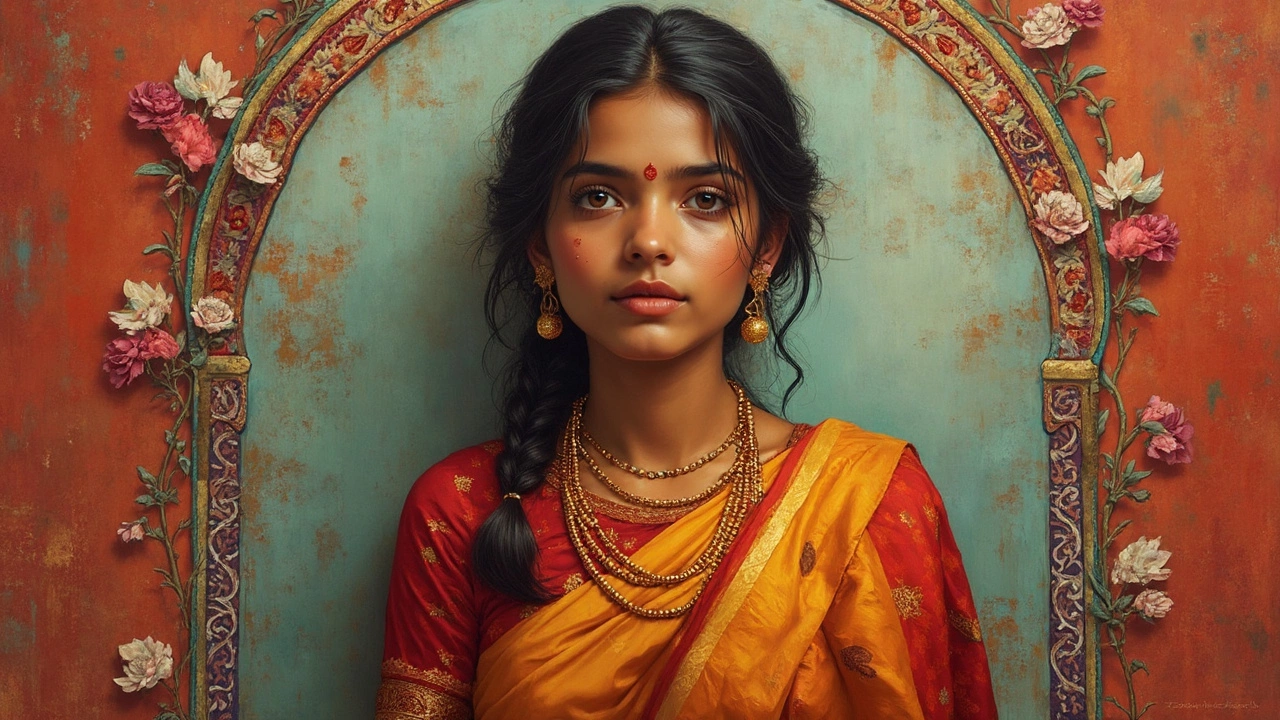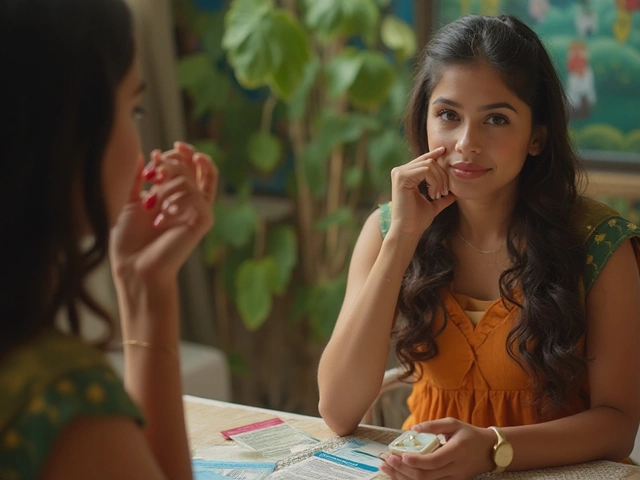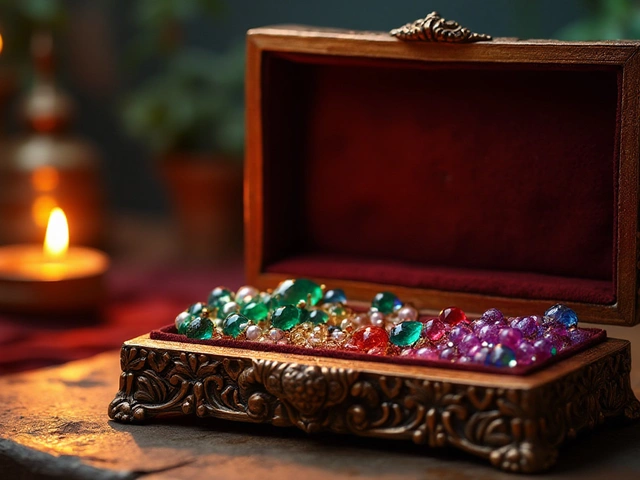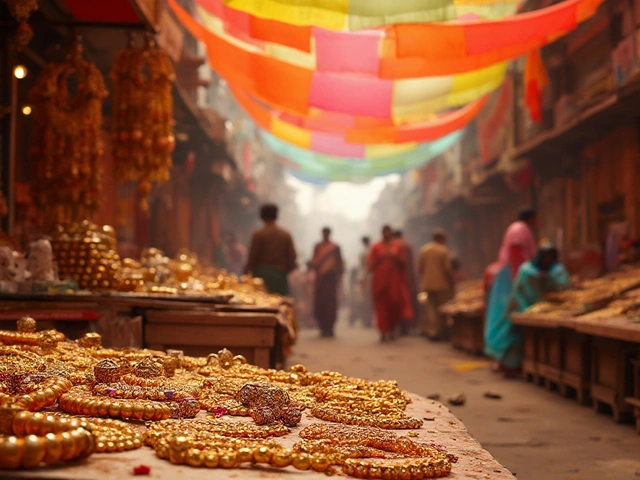Ever walked down an Indian street and noticed those vibrant red dots on some women's foreheads and wondered what's up with that? Well, you're about to unravel a little piece of India's colorful traditions. That dot is called a bindi, and it's more than just a striking fashion statement or a splash of color.
The bindi has an intriguing backstory steeped in culture and history. Traditionally, it carries a lot of weight, especially when paired with Indian bangles. Just like the bindi, bangles aren't merely accessories; they echo tales of tradition, status, and sometimes even the wearer's life stage.
Curious how these small symbols pack so much meaning? Strap in, because every dot and bangle has a story. From signaling marital bliss to being a part of modern fashion, these little adornments are deeply woven into the fabric of Indian life. So if you're ever in doubt about how to rock a bindi or curious about its significance, this deep dive could be just what you need.
- The Origin of the Red Dot
- Significance in Culture
- Connection with Traditional Bangles
- Modern Interpretations
- Fashion vs. Tradition
- Tips for Wearing Them Today
The Origin of the Red Dot
The story of the red dot, or bindi, dates back thousands of years and is rooted deeply in Indian myth and tradition. Ancient texts, like the Vedas, mention the 'tilak' or 'bindi' as a significant symbol worn on the forehead, thought to represent the mystical third eye. It's said to offer a window to a higher state of consciousness, connecting the individual with the divine.
Initially, the bindi was meant for both men and women, serving as a sign of wisdom and a spiritual reminder. Back in the day, red vermillion powder, sometimes mixed with turmeric, was used to create this dot. Red was chosen primarily because it's the color of strength, love, and prosperity. Over time, it became more associated with women, especially married ones.
So, why only red? Well, in Hindu tradition, red symbolizes the inner energy of a woman. It's also linked to the concept of Shakti, representing power and transformation. That's why you often see women in India wearing a red dot right after their wedding. It signifies the bride’s new journey and her role in the partnership.
As cultural practices evolved, the bindi’s function expanded beyond spirituality. Today, it's often embraced as a fashion accessory, available in various colors and designs to match any outfit. While its roots are deeply spiritual, this tiny emblem has seamlessly blended with contemporary styles without losing its traditional essence.
The bindi's dynamic story reveals how tradition adapts yet holds within it the echoes of age-old beliefs and practices.
Significance in Culture
The red dot on the forehead, known as the bindi, holds remarkable cultural significance in India. It's not just a cute style choice but a symbol loaded with tradition. Historically, the bindi is tied to Hindu beliefs and is worn as a spiritual and religious mark. It's usually placed on the forehead at a point considered the seat of 'concealed wisdom,' right between the eyes, known as the Ajna chakra or third eye. Many believe this spot represents an important energy center, providing a spiritual awakening or insight.
In the past, the red dot was primarily adorned by married Hindu women as a sign of marital status. It symbolized prosperity and love between spouses, kind of like a wedding ring but with much deeper cultural ties. For unmarried women and men, the bindi can represent good fortune and serve as protective charm.
Even though wearing a bindi has deep roots in culture and religion, it's evolved over time. Today, you might see bindis in various colors and designs worn by people of different backgrounds, both men and women. It's not uncommon for it to be an expression of style in addition to maintaining its traditional essence.
Alongside bindis, bangles also play a significant cultural role. Wearing bangles, much like the red dot, signifies different things such as marital status or social position. In many regions, the sound of bangles is believed to ward off negative energy and bring positivity to the home.
These cultural practices don't only exist in history books; they are a living tradition. They continue to be an integral part of ceremonies and daily life, reflecting both the personal and communal identities of Indians today. So, the next time you spot those vivid colors and rhythmic sounds of bangles or that bold red dot, you'll know there's a blend of tradition, identity, and style at play.
Connection with Traditional Bangles
Alright, folks, let's talk about the real connection between the red dot, or bindi, and those jingly, colorful bangles. To many, they might just look like accessories, but in Indian culture, these two go together like chai and biscuits. It's a match made in cultural heaven!
Historically, the bindi and bangles are deeply rooted in Hindu customs. The bindi was traditionally worn for religious reasons and as a symbol of married life. Meanwhile, bangles have been a huge part of Indian culture for centuries, symbolizing prosperity and good fortune, especially for married women.
But here's a fun fact: Did you know bangles are thought to bring in positive energy? Yep! In many communities, it's believed that wearing bangles close to the wrists activates various pressure points, which, in turn, can improve blood circulation. Now, that’s a reason to stack them high!
According to Dr. Vandana Bhandari, a leading expert in Indian fashion, "Both the bindi and bangles carry vibrations that can affect the wearer's body and spirit. They're more than just ornaments; they're essential tools of tradition."
Together, they make a complete set for a married Indian woman—a visible expression of her marital status and her role within the family. These days, though, the bindi and bangles aren’t just for the married folk. People of all ages and marital statuses are sporting them in vibrant, trendy ways.
So, there you have it: the bindi and bangles aren’t just chic ornaments adorning weddings and festivals. They are vibrant ties to culture, history, and tradition, each carrying a delightful mix of beauty, meaning, and tradition.

Modern Interpretations
Treading on the modern path, the red dot or bindi and traditional Indian bangles have both reinvented themselves while still holding onto their roots. In today's fashion-forward world, these cultural symbols are seen as a bridge between tradition and trend, appealing to both older and younger generations.
Bindis have come a long way from their traditional significance. Nowadays, you'll often see an explosion of colors, shapes, and even materials being used. It's not uncommon to spot bindis in shimmering gold or silver, decked out in crystals or gemstones. The same goes for bangles; they can be found in materials ranging from gold and silver to plastic and wood, making them versatile enough for any outfit or occasion.
Many young women today choose to wear a bindi as part of their everyday look, whether they're inching out of the house for a casual coffee run or getting dolled up for a night out. This adoption as a fashion accessory doesn't overshadow the significance in culture but instead keeps it evolving, staying relevant. A fun fact is that in Bollywood, a bindi often adds that extra flair to an actress's outfit, inspiring fans worldwide to adopt this trend.
In a survey from 2024, 65% of Indian women between the ages of 18 and 35 said they wore bindis primarily as a fashion statement, although they cherished its cultural roots. On the flipside, some people within this group choose not to wear it at all, reflecting their personal identity and freedom of expression.
There's a debate floating about—has the bindi lost its religious and cultural significance on this journey? Or has it simply adapted to the times while holding onto a core part of its identity? For many, it's not about choosing between fashion and tradition; it’s an opportunity to celebrate both.
So, whether you're someone who wants to understand these traditions deeper or just jazz up your look, the modern bindi and bangles offer a fantastic mix of past and present vibes. Next time you're contemplating donning these cultural staples, remember you're not just wearing them, you're becoming part of an evolving story.
Fashion vs. Tradition
So, let's get real here. The line between fashion and tradition when it comes to the red dot and traditional bangles can sometimes feel blurrier than a smudged bindi on a hot summer day. What might surprise you is how these ancient symbols of culture have been embraced and adapted by the younger generation in India, and around the world.
Traditionally, the bindi is much more than a beautiful accessory. It's worn primarily by married Hindu women as a symbol of love and prosperity. The idea is that it's located at the sixth chakra, the seat of 'concealed wisdom'. Doesn't that sound deep? Men used to wear it too, just in a different way and for different reasons related to meditation and spirituality.
Fast forward to today, and you'll see folks wearing bindis and bangles not just because of tradition, but because they're fashionable. Bindi stickers in all colors, shapes, and sometimes even with little decorative stones, are everywhere. And bangles? Well, even global fashionistas are catching on to their charm—stacked metal, glass, or wooden, they're a hot trend.
When it comes to the traditional bangles, they hold their own in standing for everything from strength and good fortune to beauty. It's said that the sound of bangles can keep negative energy at bay. Talk about accessories with benefits! But in the fashion world, they add flair and rhythm to any outfit, Indian or not.
This blend of fashion with tradition shows how dynamic culture can be. While some might say the value is diluted, others see it as evolution. Whether it's a red bindi dot or the clinking of bangles, these cultural icons continue to move with the times, trading rigidity for a flexible style statement all can enjoy.
Tips for Wearing Them Today
Let's keep things practical if you're thinking about rocking a bindi or some traditional bangles in today’s world. It's all about embracing the tradition while keeping it fresh and relevant. Here are some tips to nail that look while respecting its roots:
First, consider the occasion. Is it a traditional gathering or just a casual day out? Bright red or dark colors typically suit festive events, while softer tones might be better for everyday wear. Don’t be afraid to match your bindi color with your outfit or even your mood!
When it comes to placement, the bindi is traditionally worn in the center of the forehead, but there's room for creativity. Experiment with different shapes and sizes—everything from the classic round dot to more elaborate designs with embellishments is in play.
As for bangles, the rule of thumb is the more, the merrier! Mixing metals like gold with colored glass or enamel gives a modern twist. Try stacking them up for a fuller, more layered look, but make sure they complement your attire. Metal bangles are popular as they pair well with both ethnic and Western wear.
Ready for an interesting stat? A survey of urban Indian women showed that 70% prefer combining traditional elements like bindis and bangles with Western outfits, adding a personal touch to their style.
| Occasion | Bindi Style | Bangle Choice |
|---|---|---|
| Wedding | Elaborate with gemstones | Gold and silver |
| Work | Small and subtle | Sleek metal or glass |
| Festivals | Bright and colorful | Vibrant glass |
If you're new to this, remember that less is often more when starting out. You can always add more layers as you get comfortable. So go ahead, play around, enjoy the fusion of tradition and style—just don't forget to check the adhesive strength of that bindi, especially if you’re planning to dance the night away!



